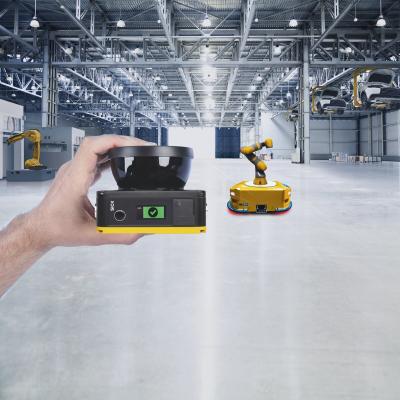
SICK is launching its newest ultra-compact safety laser scanner, nanoScan3. This product combines smart safety functions with excellent measurement data quality for accurate and reliable localization. With an overall height of just over three inches, this space- saving sensor can be used wherever machines and vehicles require maximum performance, but have minimal mounting space. This enables manufacturers to use small AGVs or mobile robots equipped with SICK’s leading-edge safety technology.
Based on successful microScan3 technology, the 2D safety sensor, nanoScan3, uses patented safeHDDM® scan technology. This enables the nanoScan3 to hold up well even in harsh or challenging ambient conditions. It is impervious to interferences like dust, contamination, and ambient light.
Benefits at a glance:
-
Small housing, measuring only 3.15 inches in height
-
Two pairs of OSSD safety outputs
-
Design suitable for industrial use and easy to integrate with standard M12 connectivity
-
Up to 128 freely configurable fields and monitoring cases
-
Direct static and encoder inputs for flexible monitoring case switching
-
Protective field range of three meters with a scanning angle of 275-degrees
-
High-precision measurement data output for navigation support via Ethernet interface
-
Maximum detection reliability even when subject to challenging ambient conditions
-
Intuitive Safety Designer software enables flexibility in configuration and diagnostics
With its small size, the nanoScan3 opens up potential applications where space is extremely critical, such as in mobile intralogistics, collaborative robots (cobots), or mobile assistance and service robotics on autonomous transport platforms and carts. What’s more, the nanoScan3 is setting a new standard in this market segment with its price-performance ratio.
From a technical approval perspective, the nanoScan3 fulfills Type 3 according to IEC EN 61496-3, SIL2 according to IEC 61508, and SIL2CL2 according to EN 62061, Category 3, as well as performance level d according to EN ISO 13849.
Contact Details
Related Glossary Terms
- robotics
robotics
Discipline involving self-actuating and self-operating devices. Robots frequently imitate human capabilities, including the ability to manipulate physical objects while evaluating and reacting appropriately to various stimuli. See industrial robot; robot.
